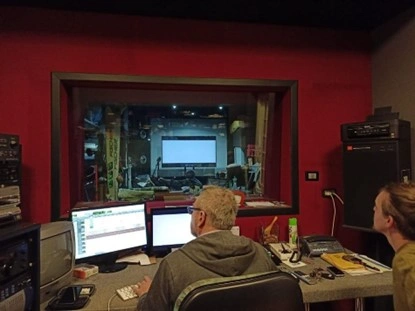Crowdfunding: Alternative & collaborative funding models

Knowledge
- Practical knowledge and advanced understanding of concepts and principles related to the origins of crowdfunding and how it has evolved over time.
- Practical knowledge about the different types of crowdfunding - reward-based, donation-based, equity-based, and debt-based.
- Practical knowledge related to case studies of successful crowdfunding campaigns to understand the strategies behind their success.
Skills
- Ability to gather, evaluate, and synthesise information from various sources related to crowdfunding.
- Analyse different crowdfunding campaigns to determine factors contributing to their success or failure.
- Plan a detailed crowdfunding campaign, including setting funding goals, timelines, and promotional activities.
- Presentation skills in front of an audience.
Responsibility & Autonomy
- Develop the ability to manage your time effectively to meet project deadlines. Set personal goals and monitor your progress throughout the WebQuest.
- Cultivate the ability to learn and explore new topics related to crowdfunding independently.
- Understand and respect the ethical considerations in crowdfunding, such as honesty, transparency, and respect for intellectual property
Crowdfunding is a transformative method of raising capital that taps into the collective power of a large number of individuals, typically through the internet. It democratizes the fundraising process, allowing anyone with a compelling idea or cause to seek financial support from the public. This innovative approach has revolutionized how entrepreneurs, artists, and activists bring their projects to life, bypassing traditional funding routes such as banks, venture capitalists, and grants.
Crowdfunding operates through various online platforms, each catering to different types of campaigns. Reward-based crowdfunding platforms like Kickstarter and Indiegogo offer backers incentives such as products, services, or unique experiences in exchange for their support. Donation-based platforms like GoFundMe are typically used for charitable causes where backers do not expect anything in return. Equity-based crowdfunding allows investors to purchase shares in a company, enabling them to become part-owners and potentially share in the profits. Debt-based crowdfunding involves lending money to individuals or businesses with the expectation of repayment with interest, providing an alternative to traditional bank loans.
The impact of crowdfunding is profound and multifaceted. It has enabled the launch of innovative products that might otherwise never have seen the light of day, supported artistic endeavours that enrich our culture, and facilitated community projects that strengthen social bonds. Crowdfunding has also empowered individuals and small organizations to address social issues, respond to crises, and bring about positive change without relying on large institutions.
However, success in crowdfunding requires more than just a great idea. It demands careful planning, compelling storytelling, and strategic marketing. Campaign creators must craft engaging pitches, develop attractive rewards, and build momentum through social media and other outreach efforts. They need to set realistic funding goals, create detailed project timelines, and maintain transparent communication with backers. Understanding these nuances is crucial for anyone looking to leverage crowdfunding effectively.
In this webquest, you will delve into the world of crowdfunding, exploring its history, types, and significant case studies. You will develop research and analytical skills as you dissect successful and unsuccessful campaigns, learning to identify the key factors that contribute to their outcomes.
Through this journey, you will gain a deep understanding of crowdfunding's potential and challenges, preparing you for future ventures in this dynamic field. Whether you are an aspiring entrepreneur, an artist, or someone passionate about a cause, the knowledge and skills you acquire through this WebQuest will equip you to harness the power of crowdfunding to achieve your goals.
Within this Webquest you will be tasked with the following:
- Research and Analysis: Investigate and understand the four main types of crowdfunding: reward-based, donation-based, equity-based, and debt-based; Analyse successful and failed crowdfunding campaigns to identify key factors that contribute to their outcomes.
- Campaign Creation: Develop a detailed and compelling crowdfunding campaign. Outline your campaign idea, including a clear description, target audience, and funding goal. Design engaging rewards or incentives for backers.
- Strategic Planning: Create a comprehensive marketing and promotional strategy for your campaign. Plan a realistic campaign timeline, including key milestones and activities.
- Evaluation and Presentation: Evaluate the pros and cons of crowdfunding based on your research and analysis. Reflect on the ethical and legal considerations involved in crowdfunding. Present your crowdfunding campaign to the class, explaining your idea, chosen crowdfunding type, strategy for success, and anticipated challenges.
Those tasks can be fulfilled both singularly or in group. If in group please assign specific roles and responsibilities within the team as follows:
Roles and Responsibilities
- Researcher: Gathers and synthesises information from various sources.
- Analyst: Examines case studies and identifies key success and failure factors.
- Creative Director: Leads brainstorming sessions and develops the campaign idea and rewards.
- Strategist: Plans the marketing and promotional activities.
- Presenter: Organises the final presentation and leads the class presentation.
To complete this WebQuest and reach the final destination of creating and presenting a compelling crowdfunding campaign, follow these steps:
Step 1: Introduction to Crowdfunding
Understand Crowdfunding Basics:
- Use the resources provided and additional ones if needed to gain a good understanding of the term “crowdfunding”.
- Check resources regarding the four main types of crowdfunding: reward-based, donation-based, equity-based, and debt-based.
- Use provided resources like articles, videos, and crowdfunding platform guides to gather information.
Step 2: Research Phase
2.1. Explore Crowdfunding Platforms:
- Visit platforms such as Kickstarter, Indiegogo, and GoFundMe, Produzioni dal Basso
- Explore different campaigns on these platforms to understand their structure and presentation.
2.2. Analyse Case Studies:
- Select and study successful and failed crowdfunding campaigns.
- Take notes on what strategies worked, what didn’t, and why.
- Look for patterns or common factors in both successes and failures.
2.3. Understand the Legal and Ethical Considerations:
- Research legal requirements and ethical considerations in crowdfunding.
- Identify common pitfalls and how to avoid them.
Step 3: Campaign Development Phase
To complete this phase use guiding questions:
- What is the core idea of your campaign?
- Who is your target audience?
- What is your funding goal and how did you determine it?
- What rewards or incentives will you offer?
- What marketing strategies will you use to promote your campaign?
- What are the potential risks and how will you mitigate them?
3.1. Brainstorm Campaign Ideas:
- Individually or in groups, brainstorm potential ideas for a hypothetical crowdfunding campaign.
- Choose an idea that is innovative, feasible, and compelling.
3.2. Create Your Campaign Outline:
- Develop a clear and concise description of your campaign idea.
- Define your target audience.
- Set a realistic funding goal and timeline.
- Design rewards or incentives for backers (if applicable).
3.3. Plan Your Marketing Strategy:
- Identify key channels for promoting your campaign (e.g., social media, email marketing, press releases).
- Plan how you will engage potential backers and maintain momentum throughout the campaign.
- Use design tools (see the resources for this webquest) to create attractive and engaging campaign posters and other promotional materials.
3.4. Research Feasibility for your Crowdfunding Campaign (Mandatory Living lab activity)
The aim is to assess the potential interest in a green crowdfunding campaign. The feasibility research could be done through the following methods:
- Interviews – you can conduct interviews with local stakeholders, including environmental and/or social groups, local businesses, and residents, to gauge interest and potential support for your crowdfunding ideas.
- Focus Groups – you can organise a focus group with community members to discuss environmental and or social issues and identify projects that could attract crowdfunding support.
- Surveys – you can develop and distribute survey to gather broader insights on what types of green, social or other initiatives people would be willing to support and use these insights to build a stronger crowdfunding campaign.
Step 4: Evaluation Phase
4.1. Evaluate Pros and Cons:
- List the potential advantages and disadvantages of your crowdfunding campaign.
- Reflect on how you will address potential challenges and risks.
4.2. Ethical and Legal Review:
- Ensure your campaign idea aligns with ethical standards and legal requirements.
- Make any necessary adjustments to comply with regulations.
Step 5: Implement your crowdfunding campaign for real! – (Optional Living lab activity)
Now try to create and launch an actual crowdfunding campaign by using one of the crowdfunding platforms by your preference from the ones you have identified during the research phase.
Don’t forget to track and report on the campaign progress.
Step 6: Presentation Phase
6.1. Prepare Your Presentation:
- Organize your research, campaign outline, and marketing strategy into a coherent presentation.
- Create visual aids such as slides or posters to support your presentation.
- Practice presenting your campaign to ensure clarity and confidence.
6.2. Present Your Campaign:
- Present your crowdfunding campaign to the class.
- Explain your idea, chosen crowdfunding type, strategy for success, and anticipated challenges.
- Answer any questions from your peers and receive feedback.
To execute the process and fulfil the task of this webquest, you will utilize a variety of web tools and resources. These resources will provide you with the necessary information, platforms, and tools to research, develop, and present your crowdfunding campaign effectively. They will also help you improve your digital literacy and soft skills.
Research and Information Gathering
- Articles and Guides:
- Crowdfunding: What It Is, How It Works, and Popular Websites.
- Crowdfunding | BCSC
- What is crowdfunding? Here are four types for startups to know
- Equity Crowdfunding 101: Is It Right For Your Startup?
- Start-up Crowdfunding Guide for Businesses
- Start-up Crowdfunding Guide for Funding Portals
- Guide on crowdfunding - European Commission
- (PDF) Crowdfunding as a Financing Alternative for Entrepreneurial Ventures
- Crowdfunding Platforms:
- Case Studies:
- Legal and Ethical Resources:
- Videos:
Digital Tools & Resources for Campaign Development and Presentation
- Graphic Design & Presentation tools:
- Canva - For creating visual content such as campaign graphics and presentation slides.
- Piktochart - For designing infographics and visual aids.
- Google Slides - For creating and sharing presentation slides.
- Prezi - For creating dynamic and engaging presentations.
As you conclude this webquest on crowdfunding, reflect on the journey you have taken. From understanding the basics of crowdfunding to analysing successful campaigns, developing your own campaign ideas, and presenting them, you have engaged in a comprehensive learning experience.
Crowdfunding exemplifies the power of collective effort and the potential of innovative ideas to attract support and make a difference. By navigating through the various stages of this webquest, you have gained valuable insights into how crowdfunding works, the strategies for success, and the challenges to be aware of. More importantly, you have developed critical skills in research, analysis, creativity, project planning, and presentation.
Take a moment to think about the process and results of your activity:
- How did your understanding of crowdfunding evolve throughout the webquest?
- What were the most challenging aspects, and how did you overcome them?
- How did working in a team enhance your learning experience?
- What strategies did you find most effective in designing your hypothetical campaign?
- How can you apply the knowledge and skills you've gained in future projects or real-life situations?
Remember, crowdfunding is not just about raising money; it's about bringing communities together, fostering innovation, and turning dreams into reality. As you move forward, consider how you can leverage the power of crowdfunding to support your own ideas, causes, or entrepreneurial ventures. The skills and knowledge you've acquired through this WebQuest are tools that can help you navigate the dynamic world of crowdfunding and beyond.
Keep exploring, keep innovating, and most importantly, keep believing in the power of collective effort. Your journey doesn't end here—it's just the beginning.
Philips' Circular Economy Initiative
A network that allows young artists to exchange their vision and passion for art.
A collective that will organise events with a broad integration of several forms of art.
They will combine musical performances/ visual arts and interactive workshops in order to create dynamic events which are accessible to all!
Their initial focus is to listen to Brussels based young talents and provide the sort of frame in which they can express their interpretation of art in a local setting without having to urge to leave to other cities to realize it there.
Link: Growfunding | échos
Source: Growfunding
Mio Fratello
Mio fratello (My brother) is a completely independent short film created by a group of young people from DAMS in Gorizia.
A family drama about what it means to grow up and the price of becoming an adult.
They are missing the final step for post-production and distribution, and that is the purpose of this campaign.
Link: Mio Fratello - Film Indipendente
Source: Produzioni dal Basso



